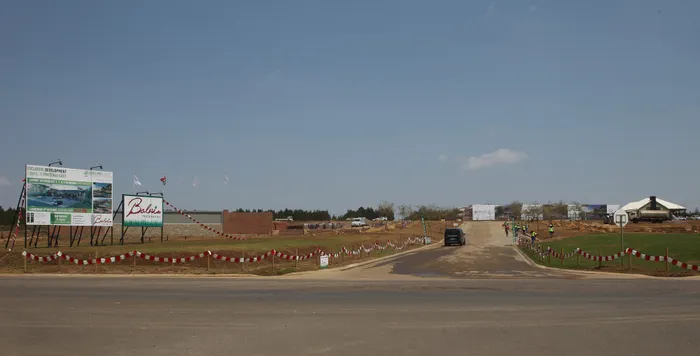Navigating material shortages and price hikes: challenges for South Africa's construction industry

The site of the Mooikloof Mega-City residential development, which was launched east of Pretoria in 2020.
Image: Jacques Naude / Independent Newspapers
The construction and built environment buyers in South Africa are facing material shortages, steep price increases, and longer lead times for essentials such as steel, aluminium, solar panels, and electrical components.
This was as the sweeping US tariffs are being felt across the globe, even affecting the construction industry at the southern tip of Africa.
“Although these are taxes on imports into the US, they have a ripple effect on local building costs as Chinese and other suppliers redirect their materials to markets without tariffs and disrupt our supply chains,” said Nolubabalo Tsolo, the executive director of the Association of South African Quantity Surveyors (ASAQS).
She explained that contractors are struggling to manage the rising costs and add risk premiums to tenders. This means that projects from roads and bridges to schools and affordable housing risk exceeding their budgets.
In addition, currency fluctuations are making dollar-priced imports even more expensive. All this puts strain on both public and private projects, with affordability and delivery timelines being reassessed.
According to the organisation that represents members who have interests in the construction industry and built environment, amidst this uncertainty, quantity surveyors (QS) were playing a crucial role in stabilising the construction sector and keeping costs under control.
“We’re the only profession specialising in the finances of the construction industry, also referred to as ‘building accountants’ (Bou-rekenaare) in Afrikaans.”
The QS’s initial estimate of the project cost-including labour, material, time, and profit-is based on information from the architects, engineers and other industry specialists.
Tsolo said they look at the current market prices in construction, combined with historical data, as well as statistical forecasts and construction and material price indices.
Ideally, the estimate also includes reserves for contingencies and escalations to cover unforeseen risks and costs during the project.
However, ASAQS said National Treasury currently does not accept contingencies (typically 5% to 10% of project value) in the public sector, and QS have to formally request additional funds for unexpected costs.
It’s meant to boost accountability, Tsolo says, adding that this spelt onerous bureaucracy, which delayed construction and drove costs even higher.
The ASAQS suggested responses to the tariff-related challenges in SA’s construction sector that included embracing dynamic pricing strategies. Together with other industry bodies, the ASAQS said it is engaging with government departments for more flexible public sector procurement frameworks to address price volatility.
But this requires regulatory clarity.
“The Standard for Infrastructure Procurement and Delivery Management stated that no escalations and contingencies should be included in the contract price (clause 14.5.9).
“However, when this regulation was replaced in 2019 with the Framework for Infrastructure Delivery and Procurement Management, it didn’t mention the escalations and contingencies,” Tsolo said
She said the sector must also focus on strengthening local supply chains. The government has been encouraging local manufacturing, but it should use the US tariffs to actively help local producers of construction materials, for example, through tax breaks and other incentives. This would reduce reliance on imports, she said.
The executive director also suggested the training of QS on integrating global economic indicators into cost planning.
ASAQS members were said to be already benefitting from evolving continuous professional improvement programmes and webinars that also tackle macroeconomic topics. Other industry bodies and partners could add value to this, she added.
“By building resilience, we intend to lessen global economic shocks on the local construction sector,” Tsolo said. “Quantity surveyors are central to this, ensuring that construction projects remain feasible, efficient, and financially sound, even in uncertain times.”
Last month, the National Home Builders Registration Council(NHBRC) told this publication that whilst high interest rates inevitably impact the affordability, or lack thereof, and increase in home construction costs, as the NHBRC, they recognised economic and environmental realities and, accordingly, encourage alternatives such as the usage of Alternative Building Technology (ABT) and Innovative Building Technologies (IBT).
The NHBRC said it is actively encouraging the usage and uptake of ABT and IBT, which are unconventional building methods or materials which are not covered by the National Building Regulations and Building Standards.
These are assessed for fitness for purpose by Agreement SA, a certification body and custodian of IBTs in the country.
Some of the notable advantages of ABT and IBT included reduced construction time, reduced life cycle cost, environmental impact, as well as innovative architectural options.
Independent Media Property
Related Topics: